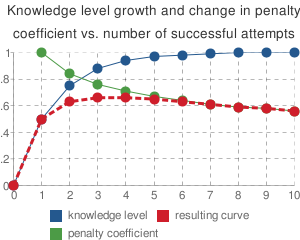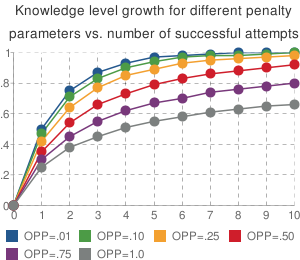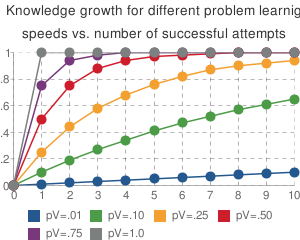Difference between revisions of "CUMULATE parametrized asymptotic knowledge assessment"
(→Example 1) |
|||
| Line 1: | Line 1: | ||
| − | [[CUMULATE parametrized asymptotic knowledge assessment| | + | [[CUMULATE]]'s [[CUMULATE parametrized asymptotic knowledge assessment|parameterized asymptotic knowledge assessment]] algorithm is an attempt to overcome shortcomings of its [[CUMULATE asymptotic knowledge assessment|non-paramterized]] version. Namely, ''one-fits-all'' nature, prohibiting parameter tuning for individual users' abilities and problem complexities. |
=Computation= | =Computation= | ||
Revision as of 21:40, 8 April 2009
CUMULATE's parameterized asymptotic knowledge assessment algorithm is an attempt to overcome shortcomings of its non-paramterized version. Namely, one-fits-all nature, prohibiting parameter tuning for individual users' abilities and problem complexities.
Computation
The formula below is used to update the knowledge levels of concepts (c) addressed in a problem (p). This formula reflects the following principles (identical to the predecessor algorithm).
- there are several domain concepts (knowledge items, rules, productions) involved in solving a problem; the knowledge of each of them is updated proportionally to the others
- knowledge is updated only upon correct user answers, there is no penalty for errors
- solving a problem correctly multiple times will result in diminishing update (growth) of the knowledge level of the concepts as the number of successes grows
in addition:
- the initial level of knowledge, speed of knowledge growth, and penalty for repetitive (correct) solutions to the problem - are now adjustable parameters
- Ko - is the starting level of knowledge, Ko ∈ [0, 1]
- res - result of user action (0 -error, 1 - correct);
- Wc,p - is a weight of concept c in problem p
- ΣWc,p - is the sum of weights of all concepts in problem p
- succattp - is a number of successful solutions to problem p prior to current attempt
- pV - speed of knowledge growth parameter, pV ∈ [0, 1]
- OPP - over-practicing parameter, controlling the penalty for repetitively solving one problem (correctly), OPP ∈ [0, 1]
Examples
Example 1
Below is a graph of concept's knowledge level growth and the penalty coefficient vs. number of successful attempts to apply it in a problem. The lines denote:
- the blue line denotes a successful use of a concept in a new problem (pV = .5)
- the green line denotes a penalty coefficient -- 1/(succattp+2)OPP -- as if it was the same problem (OPP = .25)
- the red line merges the prior two graphs

(alternatively via Google Chart API)
Example 2
Below the speed of problem learning is held constant (pV = .5) while the penalty for practicing the same problem changes.

(alternatively via Google Chart API)
Example 3
Graph below shows differences the growth of knowledge while speed of learning varies. No penalty is given.

(alternatively via Google Chart API)

